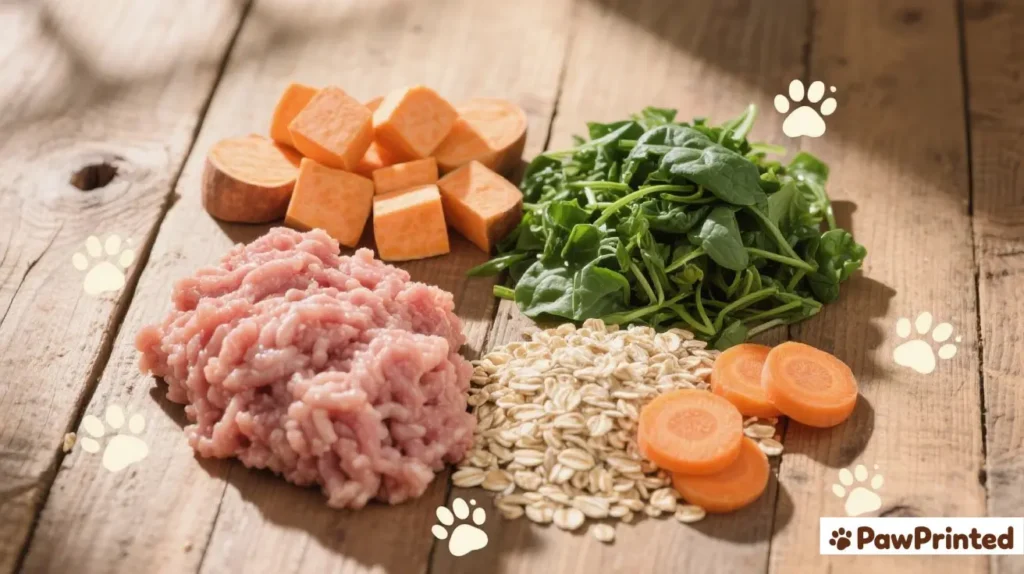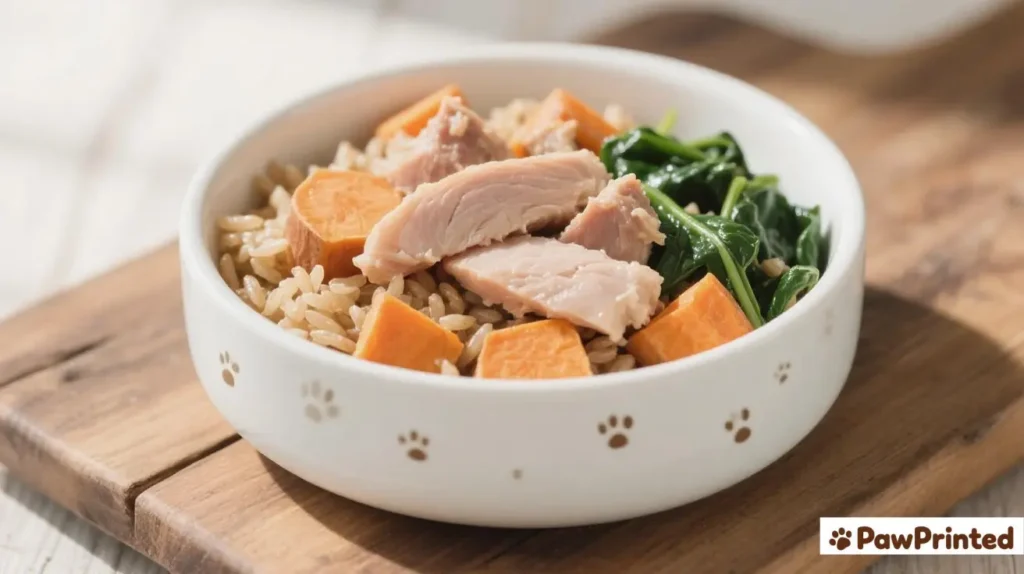When our inbox fills with “What protein is gentle but not boring?”, turkey is often the quiet winner. It’s a lean, highly digestible protein with a clean flavor that picky eaters accept and sensitive stomachs usually tolerate. Below is the practical, vet-approved way we evaluate turkey dog food—what it helps, who it suits, and how to choose the right style without guesswork.

Red flag — call your vet: sudden vomiting, black/tarry stools, rapid weight loss, repeated refusal to eat, or hives/swelling after new foods. Nutrition changes should make life calmer, not scarier.
Why Turkey Works (In Real Homes)
Lean, useful calories: Turkey supplies high-quality protein with moderate fat—easier to portion for weight-prone dogs than richer meats.
Gentle on many stomachs: Families coming from “too rich” beef or diverse poultry blends often see steadier stools when they simplify to a turkey-led formula. If your pup is recovering from tummy drama, see our Sensitive Stomach Dog Food guide for broader options.
Allergy rotation friendly: For dogs reacting to chicken or beef, turkey can be a helpful alternate protein in rotation plans. If you’re building an ingredient-first pantry, bookmark our hub: Ingredient-Based Dog Food and see the sibling article Lamb Dog Food.
Supports coat & recovery: With complete amino acids and supportive minerals (zinc/selenium), turkey helps daily maintenance—handy for active dogs or those trimming back from a chubby season.
What “Turkey Dog Food” Can Look Like
- Dry kibble: Scales well for multi-dog homes; look for named turkey (not “poultry by-product”) and steady fiber.
- Wet food: Adds moisture & aroma—great for seniors or picky eaters; we often layer a spoon on top of a dry base.
- Limited Ingredient (LID): One protein + one carb to reduce variables for suspected allergies.
- Grain-free vs grain-inclusive: Choose based on vet guidance and stool/energy tracking, not trends. Many sensitive dogs do fine on gentle grains (oats/rice).

How We Pick Turkey Formulas (Simple Checklist)
- Protein is clearly “Turkey” in the first ingredients; avoid vague blends when you’re testing tolerance.
- Moderate fat + steady fiber for predictable stools.
- Joint helpers (large breeds/seniors): glucosamine/chondroitin or fish oil omegas.
- Kibble geometry that matches size (toy vs large breed) to reduce gulping.
- Change one thing at a time; use a written transition plan (see our Dog Food Transition Guide).
Story-Based Picks (What Stayed In Our Rotation)
Everyday base: A balanced turkey-first dry that kept energy steady and stools consistent was our weekday anchor. On sluggish appetite days, a spoon of turkey wet food eased the “start eating” moment. If you prefer a ready pick, we’ve had reliable results with:
- Everyday Turkey Dry (balanced base)
- Turkey Wet Topper (aroma & moisture)
- Turkey Limited-Ingredient (simple for trials)
Note: We measure by calories, not scoops—especially for small breeds or weight-watchers. If weight creeps up, pivot to a controlled-calorie turkey formula for 6–8 weeks, then re-assess portions.

Comparison Table: Turkey Options
| Option | Why It Helps | Best For | Link |
|---|---|---|---|
| Everyday Turkey Dry | Balanced protein/fat, steady fiber, daily reliability | Most adult dogs | go/turkey-dry-everyday |
| Turkey Limited-Ingredient | One protein + one carb to reduce variables | Suspected food sensitivities | go/turkey-lid |
| Turkey Wet Topper | Moisture & aroma; boosts acceptance | Picky eaters, seniors | go/turkey-wet-topper |
Who Benefits Most (And Who Doesn’t)
Great fit: dogs reacting to chicken/beef, picky eaters needing aroma help, weight-prone pups needing leaner protein, and sensitive stomachs needing simpler blends.
Use caution or avoid: confirmed poultry allergies; working dogs needing higher fat may prefer turkey mixed with a richer protein under vet guidance.
How to Switch to Turkey (Calm 7–10 Day Plan)
- Days 1–3: 25% new (turkey) + 75% current.
- Days 4–6: 50/50 and re-check stools/energy.
- Days 7–10: 75% turkey, then 100% if all calm.
Keep treats under 10%, hold supplements steady, and log stools/weight once weekly. If things wobble, pause at the last “calm” ratio and review the transition guide.
FAQ
Not universally—both can be great proteins. Turkey is a strong option when you need leaner calories or want a clean alternate to chicken. If your dog reacts to chicken, a turkey-led limited-ingredient formula can simplify trials. See also our ingredient hub.
Skip seasoned skin, gravies, onions/garlic, and rich scraps. If you share a bite, keep it plain, boneless, and tiny. For steady nutrition, stick to complete turkey dog foods or a measured topper.
Often, yes—especially when used in a limited-ingredient recipe to reduce variables. Introduce slowly and track results 7–10 days. If signs persist, talk to your vet and review our Sensitive Stomach guide.
Choose based on stool quality, energy, and vet input. Many sensitive dogs do well on gentle grains like rice or oats. Make one change at a time use our transition plan.
Warm a spoon of turkey wet topper, use measured meals, and feed on a calm schedule. Avoid free-feeding so appetite cues stay clear.
Follow PawPrinted on Pinterest
See real-kitchen turkey bowls, portion ideas, and gentle rotation plans.

